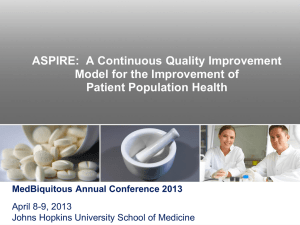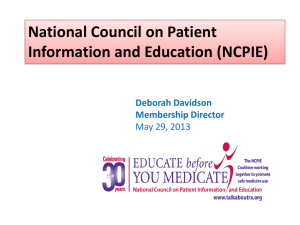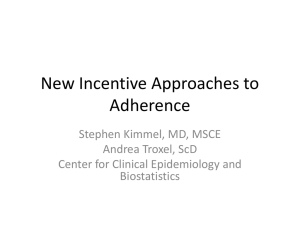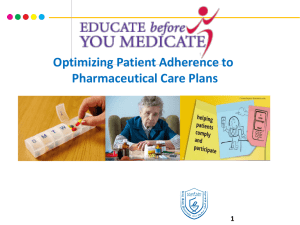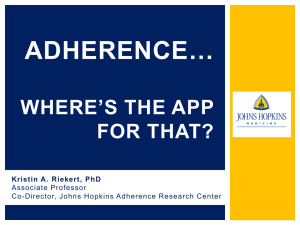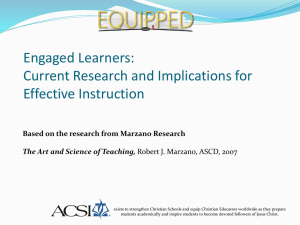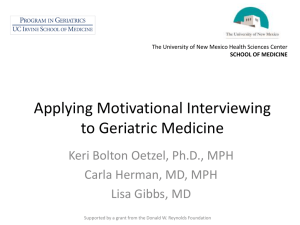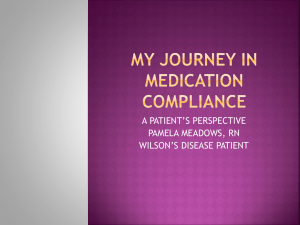Click here for the Powerpoint presentation
advertisement
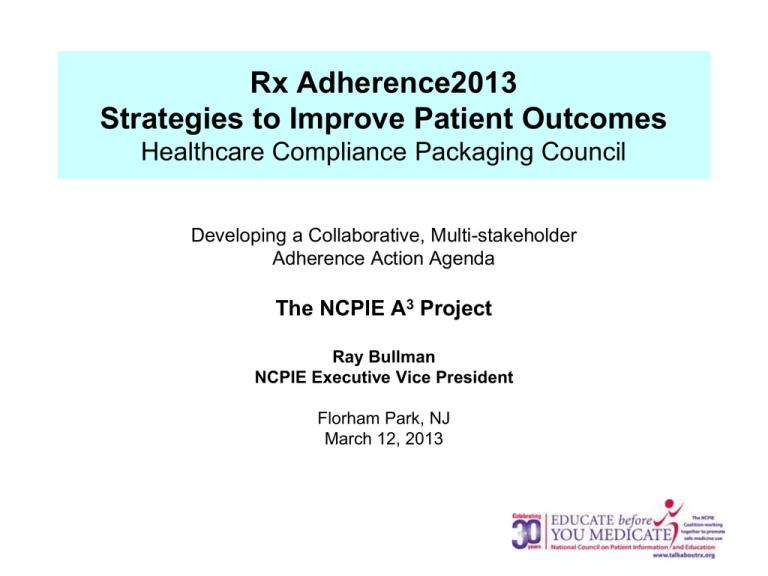
Rx Adherence2013 Strategies to Improve Patient Outcomes Healthcare Compliance Packaging Council Developing a Collaborative, Multi-stakeholder Adherence Action Agenda The NCPIE A3 Project Ray Bullman NCPIE Executive Vice President Florham Park, NJ March 12, 2013 Avoiding Yet Another Déjà Vu All Over Again Nearly 20 years ago NCPIE published “Prescription Medicine Compliance: A Review of the Baseline of Knowledge.” This 1995 report included a series of recommendations to improve adherence for: • • • • • • • Physicians and Medical Schools Pharmacists, Pharmacy-Providers and Educators Pharmaceutical Manufacturers All Health Professionals Patients Managed Care Organizations and Hospitals Nurses and Educators Avoiding Yet Another Déjà Vu All Over Again Enhancing Prescription Medicine Adherence: A National Action Plan NCPIE 2007 Report - essentially a mirror image of 1995 report findings. Medication nonadherence: a major public problem with profound health and economic consequences. The A3 Project – why re-visit adherence • Defines what NCPIE is about – stimulate and improve communication to promote safe & appropriate medicine use to consumers and Healthcare Professionals • Reset the Compass – It’s a very different world than it was 5 years ago. • Logical role for NCPIE to play (3 “Cs” ) Fulfilling the 3 “Cs” CATALYST..... CONVENER..... Collaborator ..... Long, Winding Road 1987 Priorities and Approaches for Improving Prescription Medicine Use By Older Americans 1989 Children & America's Other Drug Problem: Guidelines for Improving Prescription Medicine Use Among Children and Teenagers 1995 Prescription Medicine Compliance: A Review of the Baseline of Knowledge 1997 Enhancing Prescription Medicine Adherence: A National Action Plan 2011 Ascertaining Barriers for Compliance Project – European Union 2012 Adherence Action Agenda – NCPIE A3 Project If Not Now – When? • Awareness, action and demonstration of impact has never been greater – Seize the day... • Tech applications (operational and potential) are at an all time high and increasing • Alignment of the stars (and incentives) National Plan of Action to Advance Medication Adherence In August 2007, NCPIE released “Enhancing Prescription Medicine Adherence: A National Action Plan,” a renewed nationwide call to action for improving medication adherence through patient information and education, health professional intervention, expanded research, and supportive government policies. Report included a suggested 10-step plan of action for diverse stakeholders’ consideration. Source: “Enhancing Prescription Medicine Adherence: A National Action Plan” (NCPIE, August 2007; www.talkaboutrx.org) Recommendations for Action 1. Elevate patient adherence as a critical health care issue. 2. Agree on a common adherence terminology that will unite all stakeholders. 3. Create a public/private partnership to mount a unified national education campaign to make patient adherence a national health priority. 4. Establish a multidisciplinary approach to adherence education and management. Recommendations for Action 5. Implement professional training and increase the funding for professional education on patient medication adherence. 6. Address the barriers to patient adherence for patients with low health literacy. 7. Create the means to share information about best practices in adherence education and management. Recommendations for Action 8. Develop a curriculum on medication adherence for use in medical schools and allied health care institutions. 9. Seek regulatory changes to remove roadblocks for adherence assistance programs. 10. Increase the federal budget and stimulate rigorous research on medication adherence. The A3 Developmental Process • NCPIE surveyed cadre of key stakeholders to determine / validate A3 focus areas • NCPIE engaged a facilitator to direct stakeholder discussion / decision-making process / consensus development during two project advisory team meetings • NCPIE mission aligns with focus on adherence improvement Alignment of NCPIE’s Mission with these Focus Areas • Chronic conditions & co-morbidities: where we know taking meds safely and appropriately will make a difference in outcomes; • Patient-related factors; • Provider-related factors. Over-Arching Macro Factors • Macro factors: current drivers impacting or reshaping medical care configuration, access, delivery, payment: • • • • • • • • Practice patterns and configurations Policy change efforts Payment / Incentives Pharma innovation Packaging innovation Technology innovations & adoption Health Literacy The game of life – evidenced by the patients’ continuum of care (the journey) A3 Structure • High priority – individuals with multiple chronic conditions; • Top dyads and top triads for co-morbid chronic conditions • An across the continuum perspective: adherence improvement for one chronic condition very different than for multiple chronic conditions; very different when multiple providers are involved; • A Patients’ Medicine Journey: Many similarities / Many differences – – – – – – – Older adults with multiple chronic conditions Unrelated caregivers for older adults Aging boomers with caregiving responsibility for aging parents; Working age adults (who also manage meds in the home); Retirees Employers Others A Window into High-need Patients • Can tell a sweeping, compelling story with this approach; • Spotlights environmental challenges for vulnerable populations: living alone; transportation needs, access to providers; physical deficits (hearing, vision) • Addresses a wide range of patient, provider and systems factors A Window into High-need Patients • Patient Factors (does patient or caregiver have): – Low health literacy? – Misunderstanding or need for educational interventions? – Economic challenge, esp. inability to pay for needed meds? – Cultural beliefs that might affect adherence? – Depression or other behavioral changes – Transportation or other challenges to accessing medrelated services? (There and Home Again, 5 Responsibilities of Ambulatory Practices in High Quality Care Transitions, AMA Making Strides in Safety Program) To the Tune of “Go in and Out the ___?_____ … as you have done before **” • Adverse events – including nonadherence at the core of hospital readmission problem. • Drugs involved in 88% of emergency hospital admissions caused by ADEs of older adults: – hematologic, – endocrine, – cardiovascular, – CNS, – anti-infective agents.* * Budnitz, DS et al, N Engl J Med 2011;365:2002-12 ** Pete Seeger, Folksinger The stakes have never been higher • 2/3rds of the hospitalizations due to unintentional drug overdoses • Just 4 types of meds -- warfarin, insulins, oral antiplatelet agents and oral hypoglycemic agents – together accounted for 7 in 10 of the emergency hospitalizations. The A3 Project -- Spotlight on: • Patient – & provider-related adherence factors • Chronic & co-morbid conditions • Interplay of macro-factors • Adherence research – in development, planned; pilots, demos, best practices • Advocacy – what is not happening? how can we make it happen? • Real-time A3 Portal The A3 Project • • • • Collaborative in design (ground up) Inclusive – who is committed to change; contribution to adherence improvement. Supportive – who can help advance change and improvement? Comprehensive – key stakeholder perspectives & input Contact Information Ray Bullman Executive Vice President National Council on Patient Information and Education (NCPIE) 200-A Monroe Street, Suite 212 Rockville, MD 20850 (301) 340-3940 - phone bullman@ncpie.info – email www.talkaboutrx.org www.mustforseniors.org www.bemedwise.org www.recoveryopensdoors.org

